Management and Operations Report: BTEC Unit 4 Analysis of Soft Company
VerifiedAdded on 2022/12/15
|18
|4830
|67
Report
AI Summary
This report provides a comprehensive analysis of management and operations, focusing on the organizational structure and leadership styles within the context of Soft Company. It begins with an introduction to management and operations, followed by an examination of the organizational structure, differentiating between the roles of managers and leaders. The report delves into the strengths and weaknesses of various leadership approaches, such as situational and system leadership, and their impact on the organization. Furthermore, it explores key operational functions, the roles of managers in these functions, and the influence of external factors. The report also evaluates operational efficiencies and concludes with an assessment of the application of operations management in the wider business environment, providing recommendations for improvement.
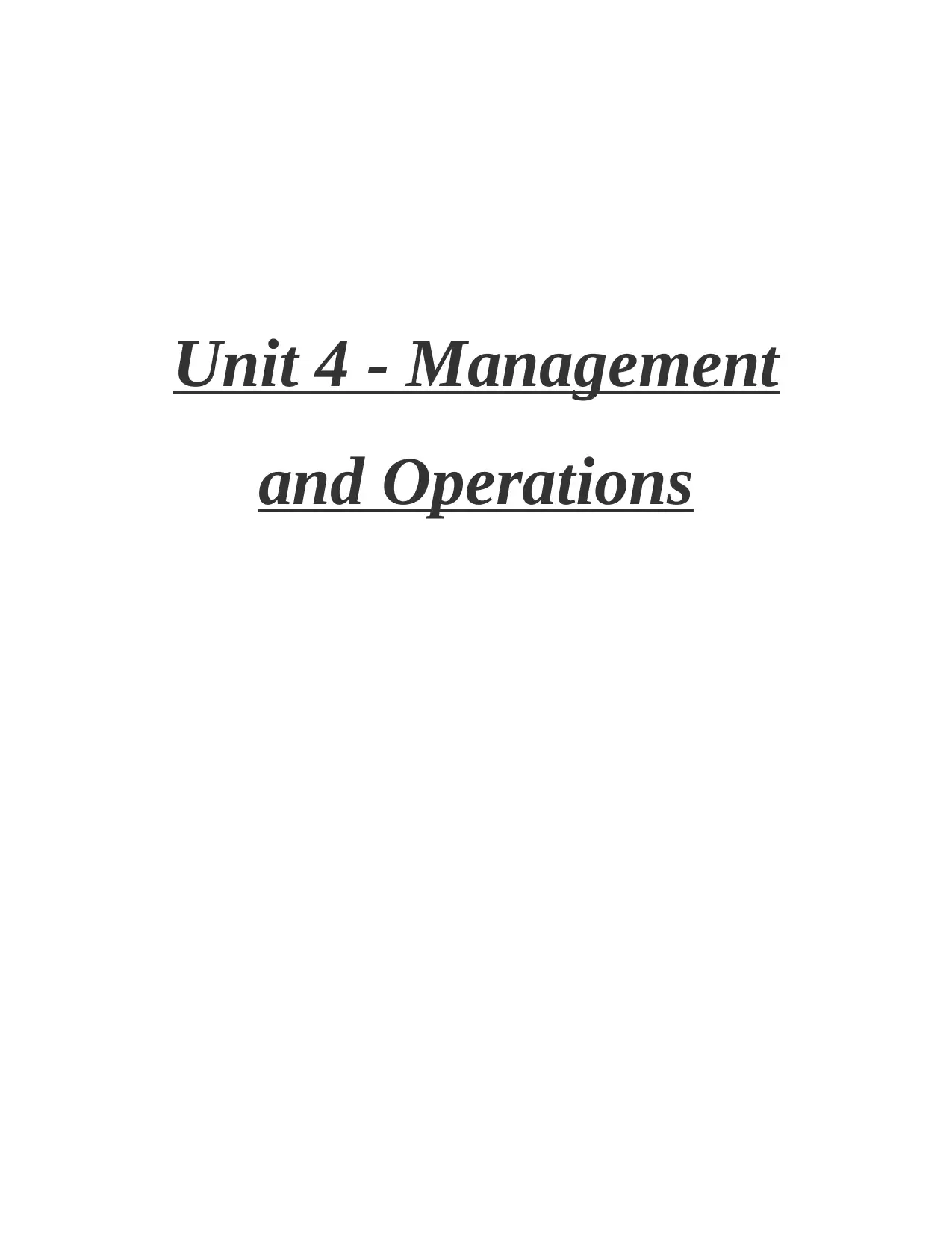
Unit 4 - Management
and Operations
and Operations
Paraphrase This Document
Need a fresh take? Get an instant paraphrase of this document with our AI Paraphraser

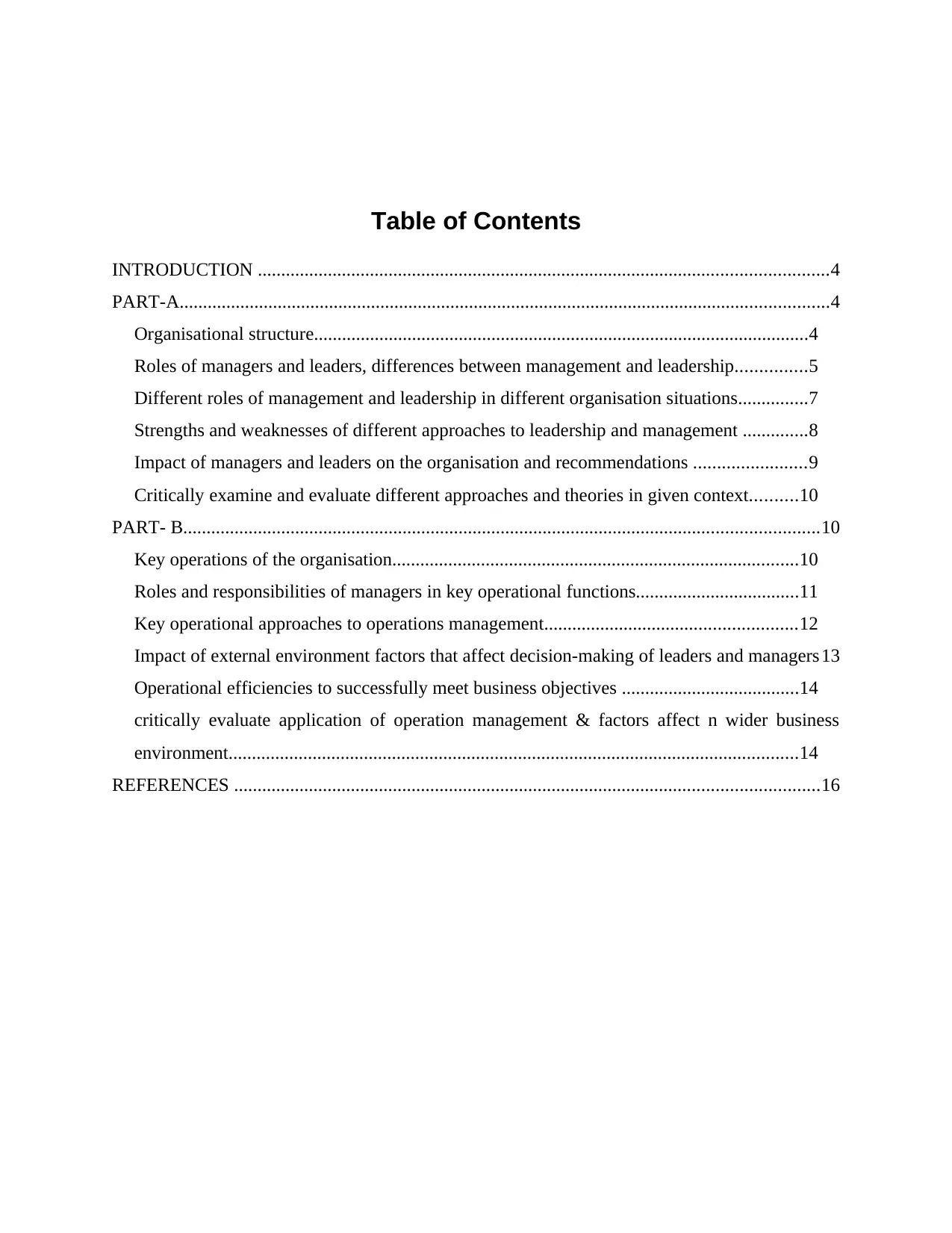
Table of Contents
INTRODUCTION ..........................................................................................................................4
PART-A...........................................................................................................................................4
Organisational structure..........................................................................................................4
Roles of managers and leaders, differences between management and leadership...............5
Different roles of management and leadership in different organisation situations...............7
Strengths and weaknesses of different approaches to leadership and management ..............8
Impact of managers and leaders on the organisation and recommendations ........................9
Critically examine and evaluate different approaches and theories in given context..........10
PART- B........................................................................................................................................10
Key operations of the organisation.......................................................................................10
Roles and responsibilities of managers in key operational functions...................................11
Key operational approaches to operations management......................................................12
Impact of external environment factors that affect decision-making of leaders and managers13
Operational efficiencies to successfully meet business objectives ......................................14
critically evaluate application of operation management & factors affect n wider business
environment..........................................................................................................................14
REFERENCES .............................................................................................................................16
INTRODUCTION ..........................................................................................................................4
PART-A...........................................................................................................................................4
Organisational structure..........................................................................................................4
Roles of managers and leaders, differences between management and leadership...............5
Different roles of management and leadership in different organisation situations...............7
Strengths and weaknesses of different approaches to leadership and management ..............8
Impact of managers and leaders on the organisation and recommendations ........................9
Critically examine and evaluate different approaches and theories in given context..........10
PART- B........................................................................................................................................10
Key operations of the organisation.......................................................................................10
Roles and responsibilities of managers in key operational functions...................................11
Key operational approaches to operations management......................................................12
Impact of external environment factors that affect decision-making of leaders and managers13
Operational efficiencies to successfully meet business objectives ......................................14
critically evaluate application of operation management & factors affect n wider business
environment..........................................................................................................................14
REFERENCES .............................................................................................................................16
⊘ This is a preview!⊘
Do you want full access?
Subscribe today to unlock all pages.

Trusted by 1+ million students worldwide
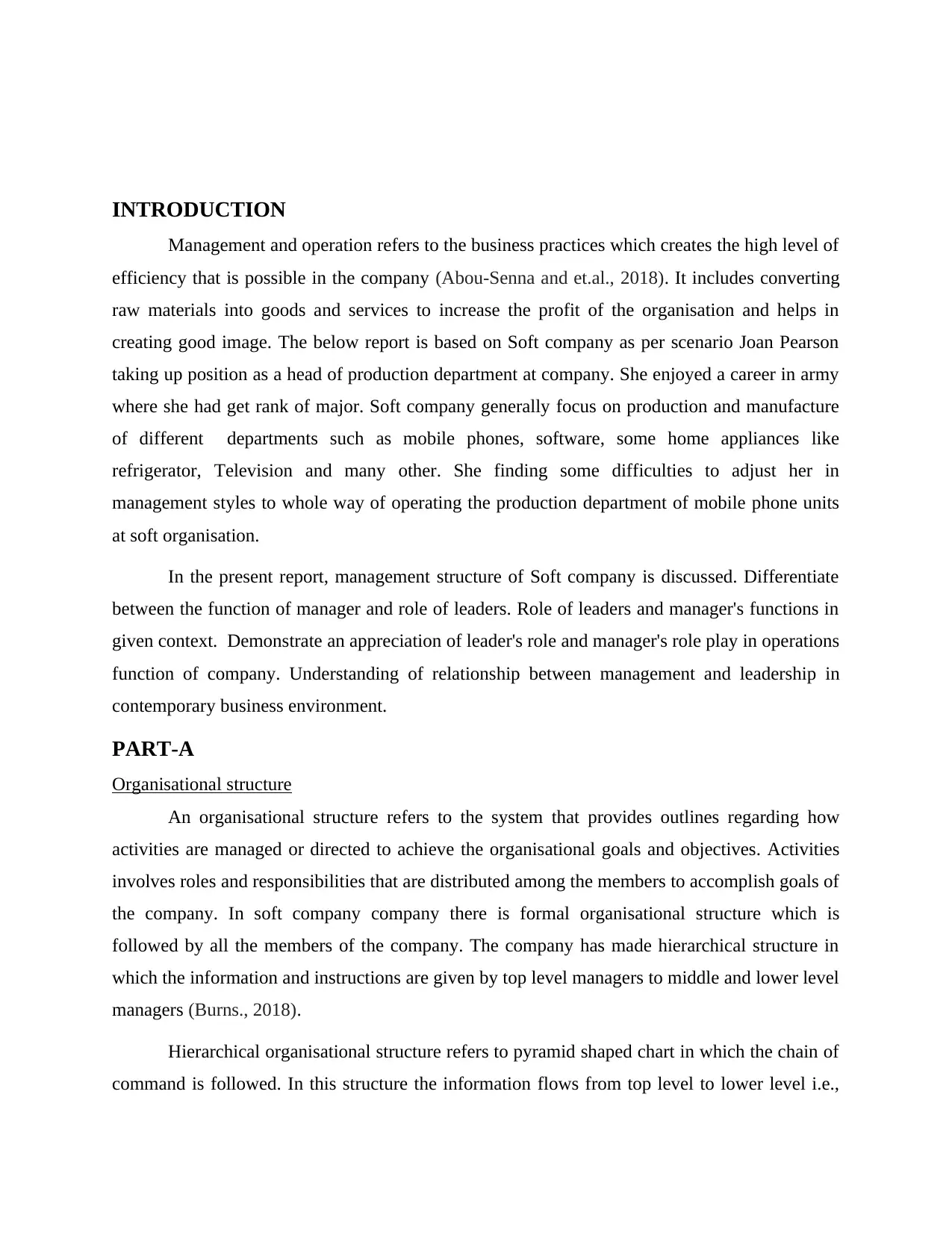
INTRODUCTION
Management and operation refers to the business practices which creates the high level of
efficiency that is possible in the company (Abou-Senna and et.al., 2018). It includes converting
raw materials into goods and services to increase the profit of the organisation and helps in
creating good image. The below report is based on Soft company as per scenario Joan Pearson
taking up position as a head of production department at company. She enjoyed a career in army
where she had get rank of major. Soft company generally focus on production and manufacture
of different departments such as mobile phones, software, some home appliances like
refrigerator, Television and many other. She finding some difficulties to adjust her in
management styles to whole way of operating the production department of mobile phone units
at soft organisation.
In the present report, management structure of Soft company is discussed. Differentiate
between the function of manager and role of leaders. Role of leaders and manager's functions in
given context. Demonstrate an appreciation of leader's role and manager's role play in operations
function of company. Understanding of relationship between management and leadership in
contemporary business environment.
PART-A
Organisational structure
An organisational structure refers to the system that provides outlines regarding how
activities are managed or directed to achieve the organisational goals and objectives. Activities
involves roles and responsibilities that are distributed among the members to accomplish goals of
the company. In soft company company there is formal organisational structure which is
followed by all the members of the company. The company has made hierarchical structure in
which the information and instructions are given by top level managers to middle and lower level
managers (Burns., 2018).
Hierarchical organisational structure refers to pyramid shaped chart in which the chain of
command is followed. In this structure the information flows from top level to lower level i.e.,
Management and operation refers to the business practices which creates the high level of
efficiency that is possible in the company (Abou-Senna and et.al., 2018). It includes converting
raw materials into goods and services to increase the profit of the organisation and helps in
creating good image. The below report is based on Soft company as per scenario Joan Pearson
taking up position as a head of production department at company. She enjoyed a career in army
where she had get rank of major. Soft company generally focus on production and manufacture
of different departments such as mobile phones, software, some home appliances like
refrigerator, Television and many other. She finding some difficulties to adjust her in
management styles to whole way of operating the production department of mobile phone units
at soft organisation.
In the present report, management structure of Soft company is discussed. Differentiate
between the function of manager and role of leaders. Role of leaders and manager's functions in
given context. Demonstrate an appreciation of leader's role and manager's role play in operations
function of company. Understanding of relationship between management and leadership in
contemporary business environment.
PART-A
Organisational structure
An organisational structure refers to the system that provides outlines regarding how
activities are managed or directed to achieve the organisational goals and objectives. Activities
involves roles and responsibilities that are distributed among the members to accomplish goals of
the company. In soft company company there is formal organisational structure which is
followed by all the members of the company. The company has made hierarchical structure in
which the information and instructions are given by top level managers to middle and lower level
managers (Burns., 2018).
Hierarchical organisational structure refers to pyramid shaped chart in which the chain of
command is followed. In this structure the information flows from top level to lower level i.e.,
Paraphrase This Document
Need a fresh take? Get an instant paraphrase of this document with our AI Paraphraser
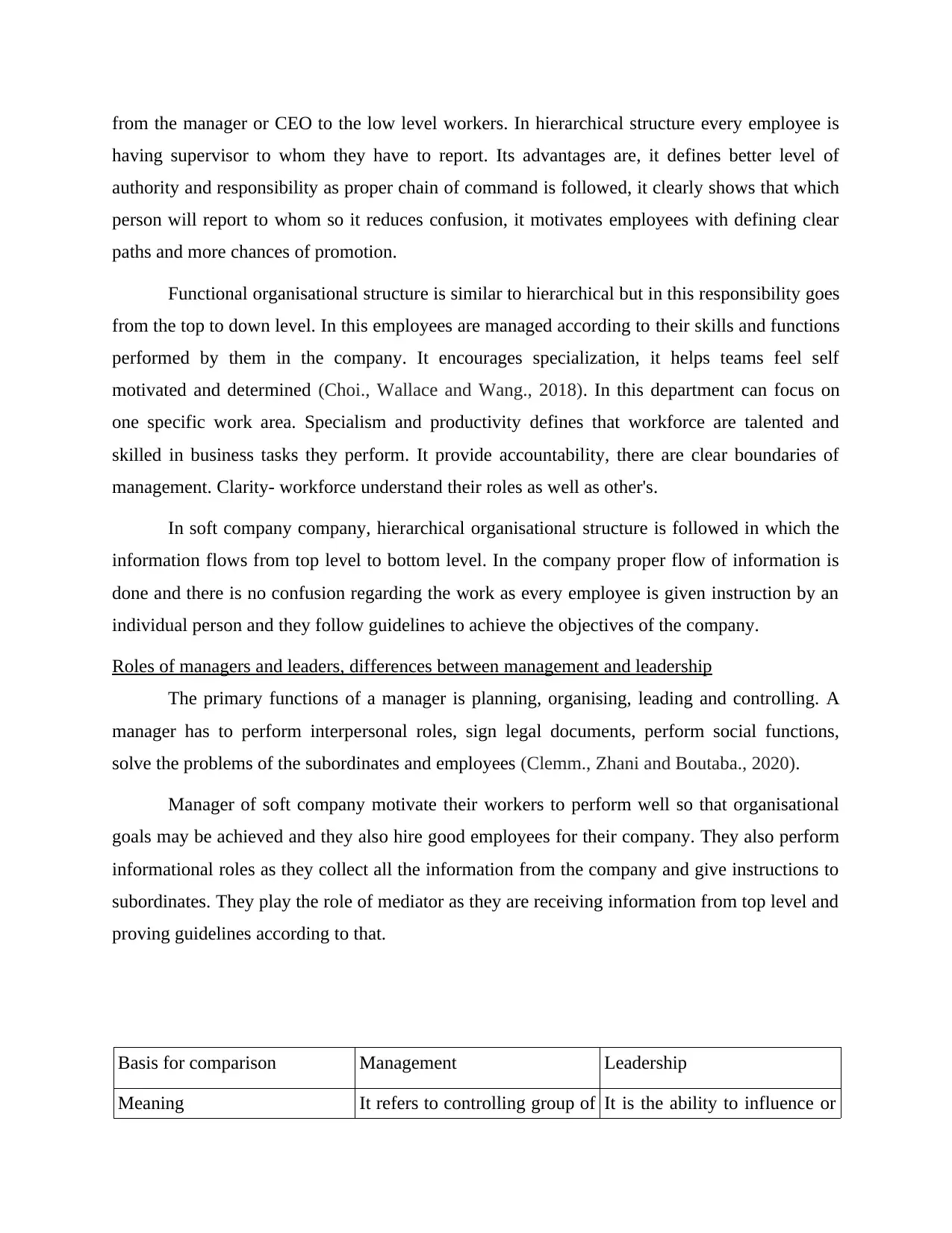
from the manager or CEO to the low level workers. In hierarchical structure every employee is
having supervisor to whom they have to report. Its advantages are, it defines better level of
authority and responsibility as proper chain of command is followed, it clearly shows that which
person will report to whom so it reduces confusion, it motivates employees with defining clear
paths and more chances of promotion.
Functional organisational structure is similar to hierarchical but in this responsibility goes
from the top to down level. In this employees are managed according to their skills and functions
performed by them in the company. It encourages specialization, it helps teams feel self
motivated and determined (Choi., Wallace and Wang., 2018). In this department can focus on
one specific work area. Specialism and productivity defines that workforce are talented and
skilled in business tasks they perform. It provide accountability, there are clear boundaries of
management. Clarity- workforce understand their roles as well as other's.
In soft company company, hierarchical organisational structure is followed in which the
information flows from top level to bottom level. In the company proper flow of information is
done and there is no confusion regarding the work as every employee is given instruction by an
individual person and they follow guidelines to achieve the objectives of the company.
Roles of managers and leaders, differences between management and leadership
The primary functions of a manager is planning, organising, leading and controlling. A
manager has to perform interpersonal roles, sign legal documents, perform social functions,
solve the problems of the subordinates and employees (Clemm., Zhani and Boutaba., 2020).
Manager of soft company motivate their workers to perform well so that organisational
goals may be achieved and they also hire good employees for their company. They also perform
informational roles as they collect all the information from the company and give instructions to
subordinates. They play the role of mediator as they are receiving information from top level and
proving guidelines according to that.
Basis for comparison Management Leadership
Meaning It refers to controlling group of It is the ability to influence or
having supervisor to whom they have to report. Its advantages are, it defines better level of
authority and responsibility as proper chain of command is followed, it clearly shows that which
person will report to whom so it reduces confusion, it motivates employees with defining clear
paths and more chances of promotion.
Functional organisational structure is similar to hierarchical but in this responsibility goes
from the top to down level. In this employees are managed according to their skills and functions
performed by them in the company. It encourages specialization, it helps teams feel self
motivated and determined (Choi., Wallace and Wang., 2018). In this department can focus on
one specific work area. Specialism and productivity defines that workforce are talented and
skilled in business tasks they perform. It provide accountability, there are clear boundaries of
management. Clarity- workforce understand their roles as well as other's.
In soft company company, hierarchical organisational structure is followed in which the
information flows from top level to bottom level. In the company proper flow of information is
done and there is no confusion regarding the work as every employee is given instruction by an
individual person and they follow guidelines to achieve the objectives of the company.
Roles of managers and leaders, differences between management and leadership
The primary functions of a manager is planning, organising, leading and controlling. A
manager has to perform interpersonal roles, sign legal documents, perform social functions,
solve the problems of the subordinates and employees (Clemm., Zhani and Boutaba., 2020).
Manager of soft company motivate their workers to perform well so that organisational
goals may be achieved and they also hire good employees for their company. They also perform
informational roles as they collect all the information from the company and give instructions to
subordinates. They play the role of mediator as they are receiving information from top level and
proving guidelines according to that.
Basis for comparison Management Leadership
Meaning It refers to controlling group of It is the ability to influence or
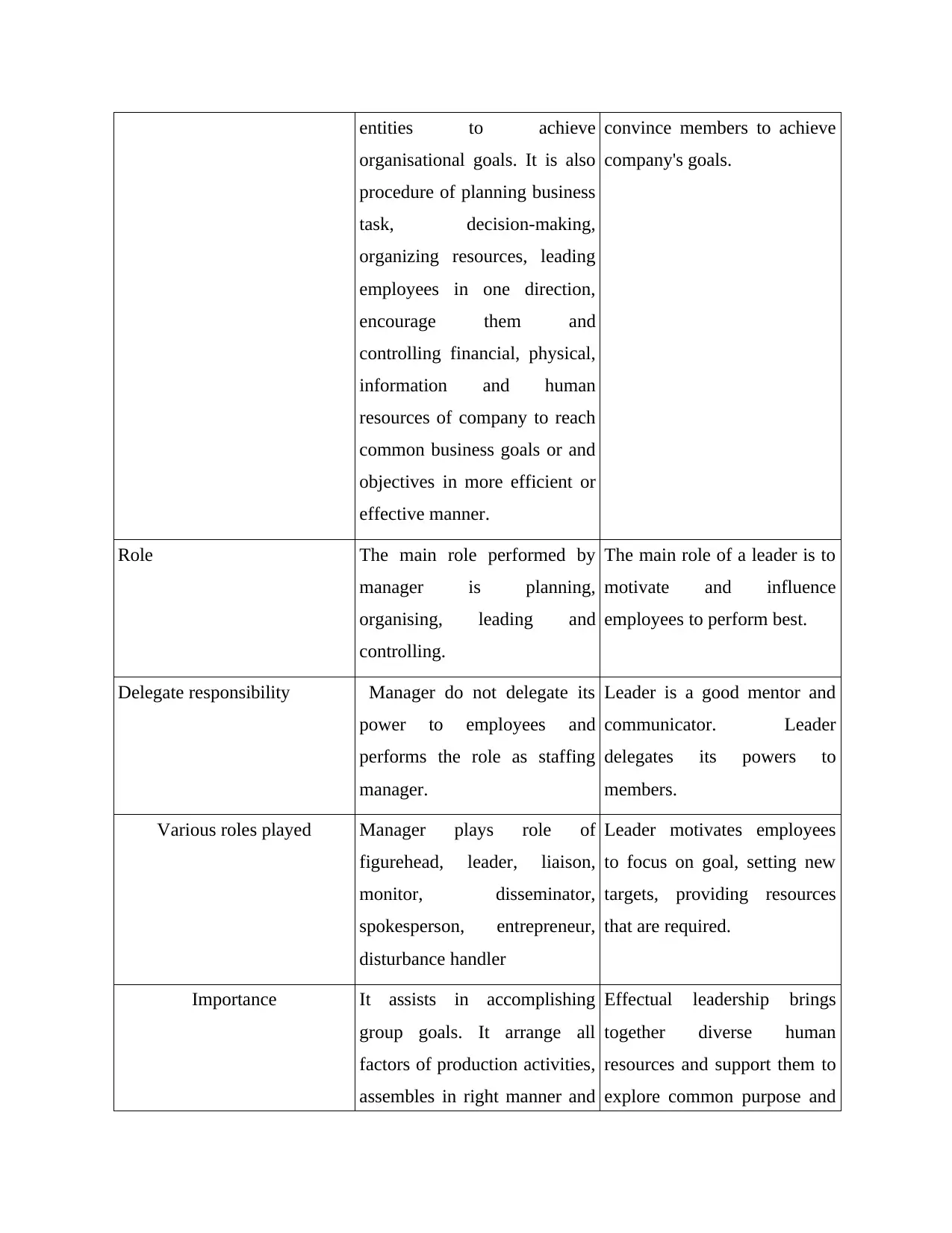
entities to achieve
organisational goals. It is also
procedure of planning business
task, decision-making,
organizing resources, leading
employees in one direction,
encourage them and
controlling financial, physical,
information and human
resources of company to reach
common business goals or and
objectives in more efficient or
effective manner.
convince members to achieve
company's goals.
Role The main role performed by
manager is planning,
organising, leading and
controlling.
The main role of a leader is to
motivate and influence
employees to perform best.
Delegate responsibility Manager do not delegate its
power to employees and
performs the role as staffing
manager.
Leader is a good mentor and
communicator. Leader
delegates its powers to
members.
Various roles played Manager plays role of
figurehead, leader, liaison,
monitor, disseminator,
spokesperson, entrepreneur,
disturbance handler
Leader motivates employees
to focus on goal, setting new
targets, providing resources
that are required.
Importance It assists in accomplishing
group goals. It arrange all
factors of production activities,
assembles in right manner and
Effectual leadership brings
together diverse human
resources and support them to
explore common purpose and
organisational goals. It is also
procedure of planning business
task, decision-making,
organizing resources, leading
employees in one direction,
encourage them and
controlling financial, physical,
information and human
resources of company to reach
common business goals or and
objectives in more efficient or
effective manner.
convince members to achieve
company's goals.
Role The main role performed by
manager is planning,
organising, leading and
controlling.
The main role of a leader is to
motivate and influence
employees to perform best.
Delegate responsibility Manager do not delegate its
power to employees and
performs the role as staffing
manager.
Leader is a good mentor and
communicator. Leader
delegates its powers to
members.
Various roles played Manager plays role of
figurehead, leader, liaison,
monitor, disseminator,
spokesperson, entrepreneur,
disturbance handler
Leader motivates employees
to focus on goal, setting new
targets, providing resources
that are required.
Importance It assists in accomplishing
group goals. It arrange all
factors of production activities,
assembles in right manner and
Effectual leadership brings
together diverse human
resources and support them to
explore common purpose and
⊘ This is a preview!⊘
Do you want full access?
Subscribe today to unlock all pages.

Trusted by 1+ million students worldwide
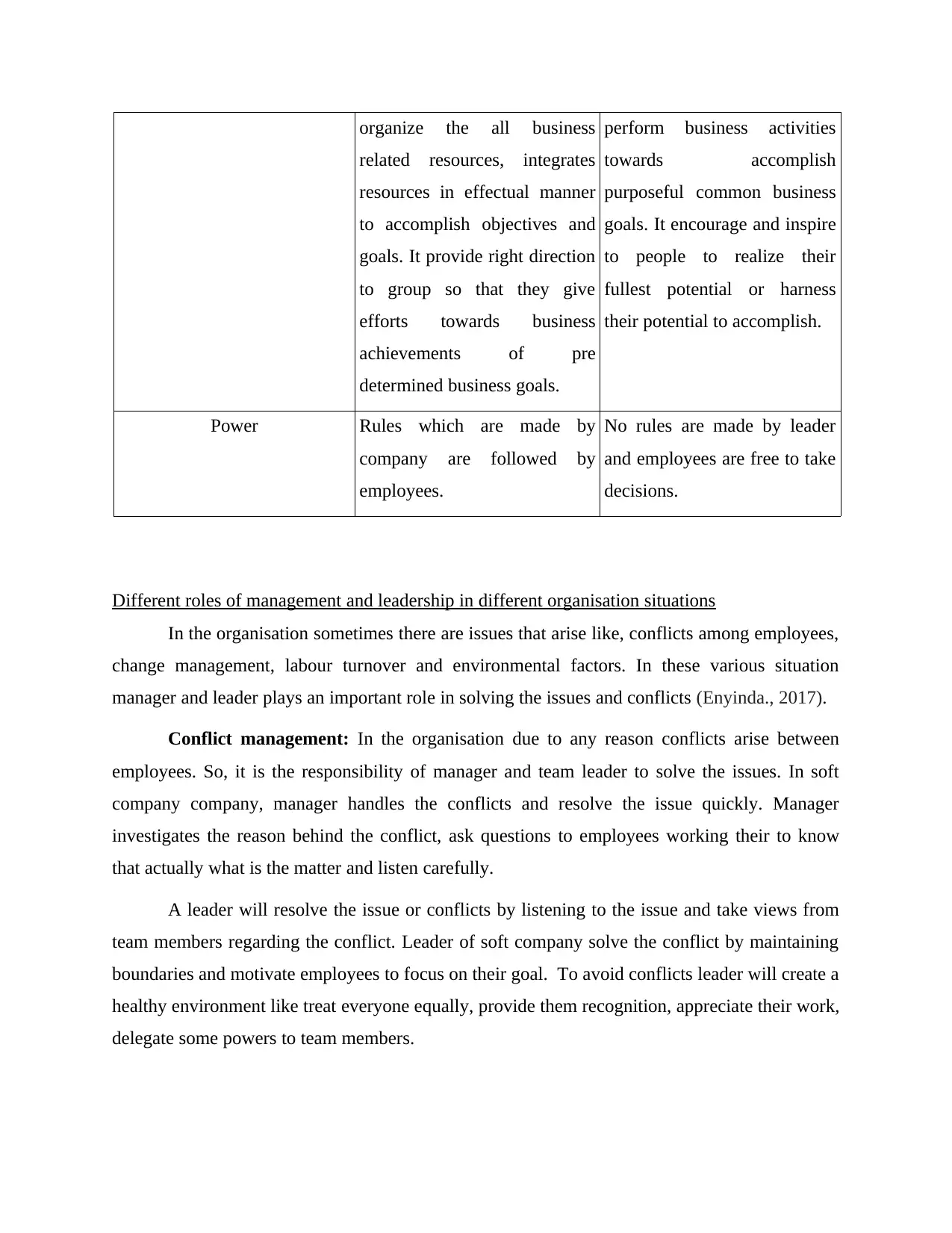
organize the all business
related resources, integrates
resources in effectual manner
to accomplish objectives and
goals. It provide right direction
to group so that they give
efforts towards business
achievements of pre
determined business goals.
perform business activities
towards accomplish
purposeful common business
goals. It encourage and inspire
to people to realize their
fullest potential or harness
their potential to accomplish.
Power Rules which are made by
company are followed by
employees.
No rules are made by leader
and employees are free to take
decisions.
Different roles of management and leadership in different organisation situations
In the organisation sometimes there are issues that arise like, conflicts among employees,
change management, labour turnover and environmental factors. In these various situation
manager and leader plays an important role in solving the issues and conflicts (Enyinda., 2017).
Conflict management: In the organisation due to any reason conflicts arise between
employees. So, it is the responsibility of manager and team leader to solve the issues. In soft
company company, manager handles the conflicts and resolve the issue quickly. Manager
investigates the reason behind the conflict, ask questions to employees working their to know
that actually what is the matter and listen carefully.
A leader will resolve the issue or conflicts by listening to the issue and take views from
team members regarding the conflict. Leader of soft company solve the conflict by maintaining
boundaries and motivate employees to focus on their goal. To avoid conflicts leader will create a
healthy environment like treat everyone equally, provide them recognition, appreciate their work,
delegate some powers to team members.
related resources, integrates
resources in effectual manner
to accomplish objectives and
goals. It provide right direction
to group so that they give
efforts towards business
achievements of pre
determined business goals.
perform business activities
towards accomplish
purposeful common business
goals. It encourage and inspire
to people to realize their
fullest potential or harness
their potential to accomplish.
Power Rules which are made by
company are followed by
employees.
No rules are made by leader
and employees are free to take
decisions.
Different roles of management and leadership in different organisation situations
In the organisation sometimes there are issues that arise like, conflicts among employees,
change management, labour turnover and environmental factors. In these various situation
manager and leader plays an important role in solving the issues and conflicts (Enyinda., 2017).
Conflict management: In the organisation due to any reason conflicts arise between
employees. So, it is the responsibility of manager and team leader to solve the issues. In soft
company company, manager handles the conflicts and resolve the issue quickly. Manager
investigates the reason behind the conflict, ask questions to employees working their to know
that actually what is the matter and listen carefully.
A leader will resolve the issue or conflicts by listening to the issue and take views from
team members regarding the conflict. Leader of soft company solve the conflict by maintaining
boundaries and motivate employees to focus on their goal. To avoid conflicts leader will create a
healthy environment like treat everyone equally, provide them recognition, appreciate their work,
delegate some powers to team members.
Paraphrase This Document
Need a fresh take? Get an instant paraphrase of this document with our AI Paraphraser
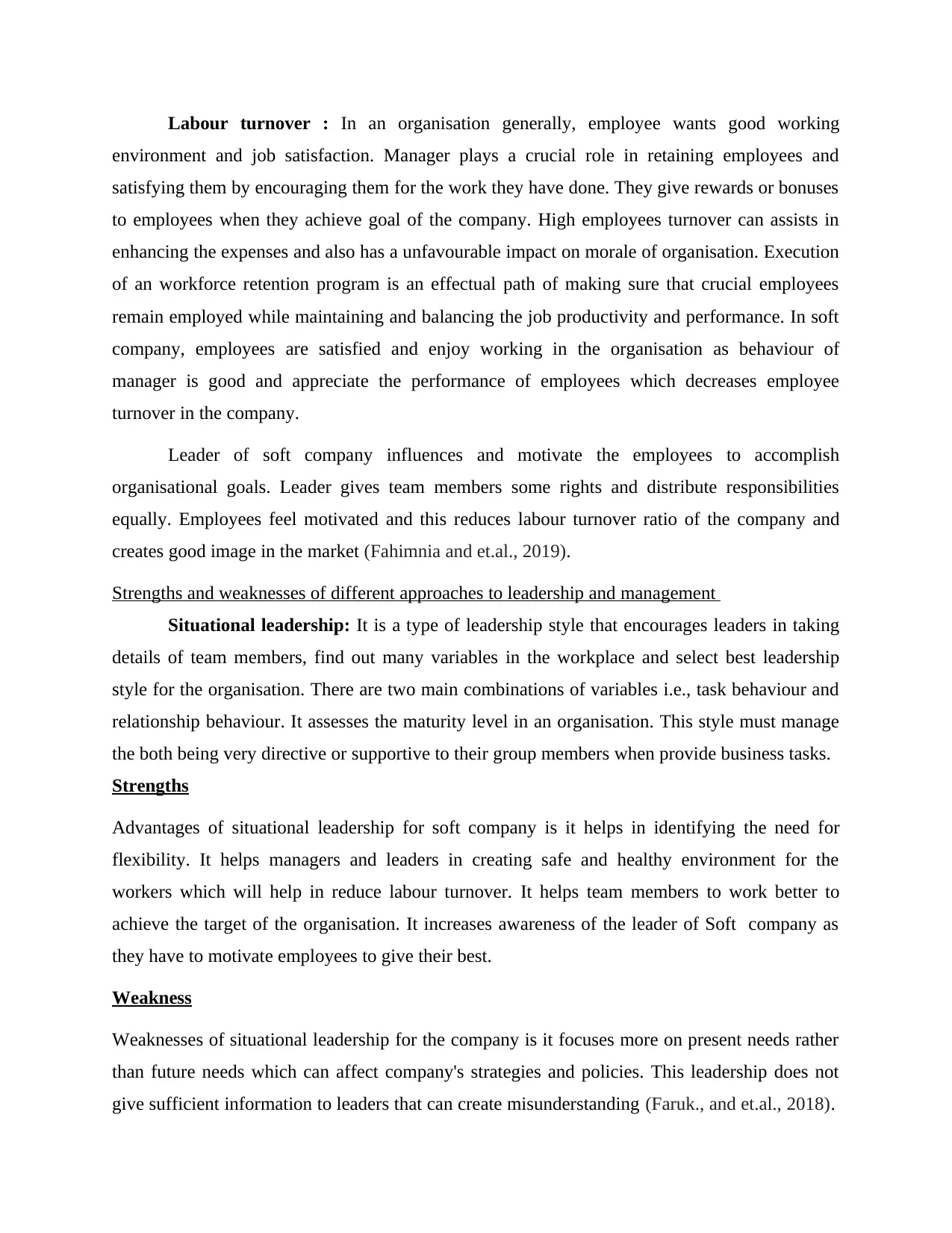
Labour turnover : In an organisation generally, employee wants good working
environment and job satisfaction. Manager plays a crucial role in retaining employees and
satisfying them by encouraging them for the work they have done. They give rewards or bonuses
to employees when they achieve goal of the company. High employees turnover can assists in
enhancing the expenses and also has a unfavourable impact on morale of organisation. Execution
of an workforce retention program is an effectual path of making sure that crucial employees
remain employed while maintaining and balancing the job productivity and performance. In soft
company, employees are satisfied and enjoy working in the organisation as behaviour of
manager is good and appreciate the performance of employees which decreases employee
turnover in the company.
Leader of soft company influences and motivate the employees to accomplish
organisational goals. Leader gives team members some rights and distribute responsibilities
equally. Employees feel motivated and this reduces labour turnover ratio of the company and
creates good image in the market (Fahimnia and et.al., 2019).
Strengths and weaknesses of different approaches to leadership and management
Situational leadership: It is a type of leadership style that encourages leaders in taking
details of team members, find out many variables in the workplace and select best leadership
style for the organisation. There are two main combinations of variables i.e., task behaviour and
relationship behaviour. It assesses the maturity level in an organisation. This style must manage
the both being very directive or supportive to their group members when provide business tasks.
Strengths
Advantages of situational leadership for soft company is it helps in identifying the need for
flexibility. It helps managers and leaders in creating safe and healthy environment for the
workers which will help in reduce labour turnover. It helps team members to work better to
achieve the target of the organisation. It increases awareness of the leader of Soft company as
they have to motivate employees to give their best.
Weakness
Weaknesses of situational leadership for the company is it focuses more on present needs rather
than future needs which can affect company's strategies and policies. This leadership does not
give sufficient information to leaders that can create misunderstanding (Faruk., and et.al., 2018).
environment and job satisfaction. Manager plays a crucial role in retaining employees and
satisfying them by encouraging them for the work they have done. They give rewards or bonuses
to employees when they achieve goal of the company. High employees turnover can assists in
enhancing the expenses and also has a unfavourable impact on morale of organisation. Execution
of an workforce retention program is an effectual path of making sure that crucial employees
remain employed while maintaining and balancing the job productivity and performance. In soft
company, employees are satisfied and enjoy working in the organisation as behaviour of
manager is good and appreciate the performance of employees which decreases employee
turnover in the company.
Leader of soft company influences and motivate the employees to accomplish
organisational goals. Leader gives team members some rights and distribute responsibilities
equally. Employees feel motivated and this reduces labour turnover ratio of the company and
creates good image in the market (Fahimnia and et.al., 2019).
Strengths and weaknesses of different approaches to leadership and management
Situational leadership: It is a type of leadership style that encourages leaders in taking
details of team members, find out many variables in the workplace and select best leadership
style for the organisation. There are two main combinations of variables i.e., task behaviour and
relationship behaviour. It assesses the maturity level in an organisation. This style must manage
the both being very directive or supportive to their group members when provide business tasks.
Strengths
Advantages of situational leadership for soft company is it helps in identifying the need for
flexibility. It helps managers and leaders in creating safe and healthy environment for the
workers which will help in reduce labour turnover. It helps team members to work better to
achieve the target of the organisation. It increases awareness of the leader of Soft company as
they have to motivate employees to give their best.
Weakness
Weaknesses of situational leadership for the company is it focuses more on present needs rather
than future needs which can affect company's strategies and policies. This leadership does not
give sufficient information to leaders that can create misunderstanding (Faruk., and et.al., 2018).
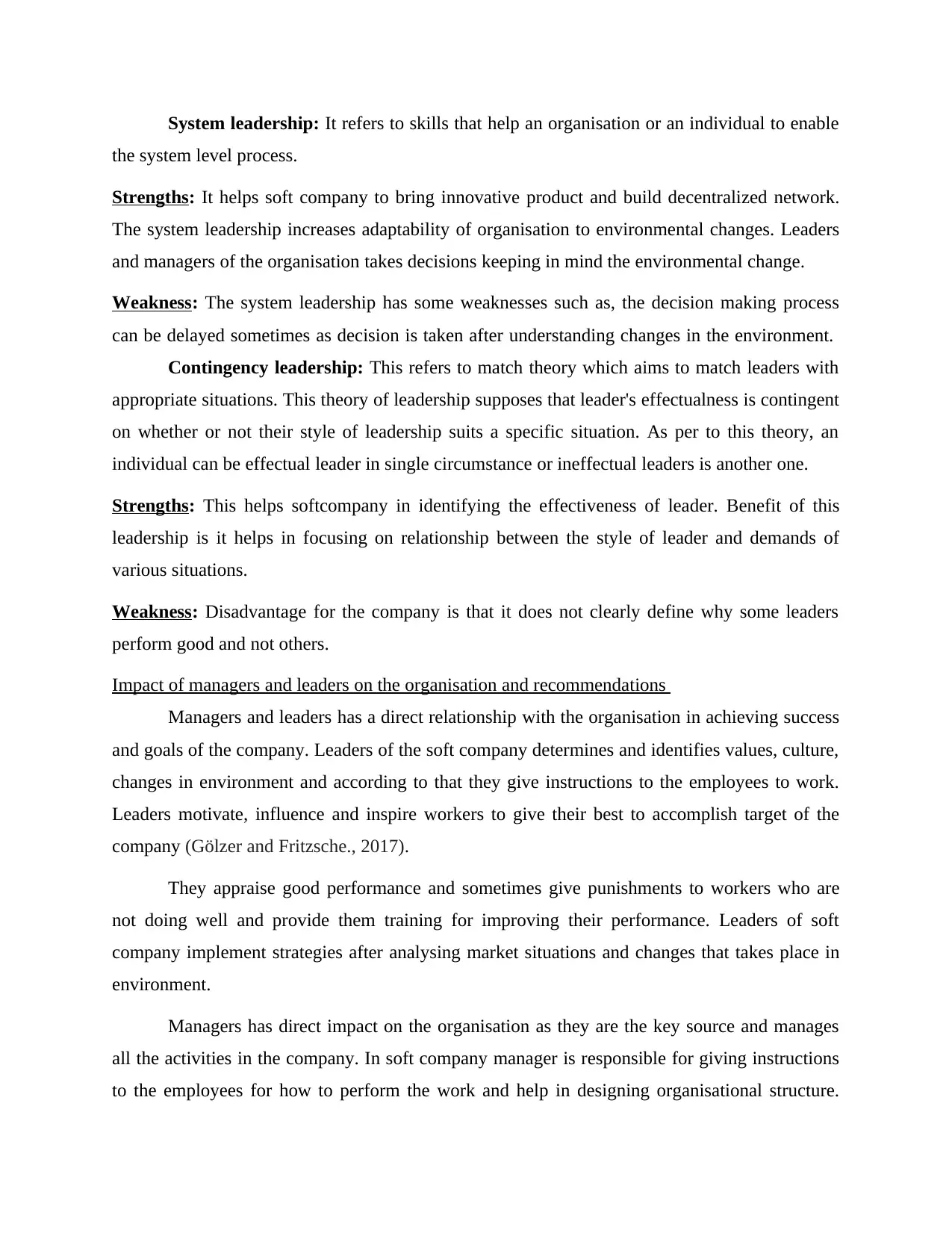
System leadership: It refers to skills that help an organisation or an individual to enable
the system level process.
Strengths: It helps soft company to bring innovative product and build decentralized network.
The system leadership increases adaptability of organisation to environmental changes. Leaders
and managers of the organisation takes decisions keeping in mind the environmental change.
Weakness: The system leadership has some weaknesses such as, the decision making process
can be delayed sometimes as decision is taken after understanding changes in the environment.
Contingency leadership: This refers to match theory which aims to match leaders with
appropriate situations. This theory of leadership supposes that leader's effectualness is contingent
on whether or not their style of leadership suits a specific situation. As per to this theory, an
individual can be effectual leader in single circumstance or ineffectual leaders is another one.
Strengths: This helps softcompany in identifying the effectiveness of leader. Benefit of this
leadership is it helps in focusing on relationship between the style of leader and demands of
various situations.
Weakness: Disadvantage for the company is that it does not clearly define why some leaders
perform good and not others.
Impact of managers and leaders on the organisation and recommendations
Managers and leaders has a direct relationship with the organisation in achieving success
and goals of the company. Leaders of the soft company determines and identifies values, culture,
changes in environment and according to that they give instructions to the employees to work.
Leaders motivate, influence and inspire workers to give their best to accomplish target of the
company (Gölzer and Fritzsche., 2017).
They appraise good performance and sometimes give punishments to workers who are
not doing well and provide them training for improving their performance. Leaders of soft
company implement strategies after analysing market situations and changes that takes place in
environment.
Managers has direct impact on the organisation as they are the key source and manages
all the activities in the company. In soft company manager is responsible for giving instructions
to the employees for how to perform the work and help in designing organisational structure.
the system level process.
Strengths: It helps soft company to bring innovative product and build decentralized network.
The system leadership increases adaptability of organisation to environmental changes. Leaders
and managers of the organisation takes decisions keeping in mind the environmental change.
Weakness: The system leadership has some weaknesses such as, the decision making process
can be delayed sometimes as decision is taken after understanding changes in the environment.
Contingency leadership: This refers to match theory which aims to match leaders with
appropriate situations. This theory of leadership supposes that leader's effectualness is contingent
on whether or not their style of leadership suits a specific situation. As per to this theory, an
individual can be effectual leader in single circumstance or ineffectual leaders is another one.
Strengths: This helps softcompany in identifying the effectiveness of leader. Benefit of this
leadership is it helps in focusing on relationship between the style of leader and demands of
various situations.
Weakness: Disadvantage for the company is that it does not clearly define why some leaders
perform good and not others.
Impact of managers and leaders on the organisation and recommendations
Managers and leaders has a direct relationship with the organisation in achieving success
and goals of the company. Leaders of the soft company determines and identifies values, culture,
changes in environment and according to that they give instructions to the employees to work.
Leaders motivate, influence and inspire workers to give their best to accomplish target of the
company (Gölzer and Fritzsche., 2017).
They appraise good performance and sometimes give punishments to workers who are
not doing well and provide them training for improving their performance. Leaders of soft
company implement strategies after analysing market situations and changes that takes place in
environment.
Managers has direct impact on the organisation as they are the key source and manages
all the activities in the company. In soft company manager is responsible for giving instructions
to the employees for how to perform the work and help in designing organisational structure.
⊘ This is a preview!⊘
Do you want full access?
Subscribe today to unlock all pages.

Trusted by 1+ million students worldwide
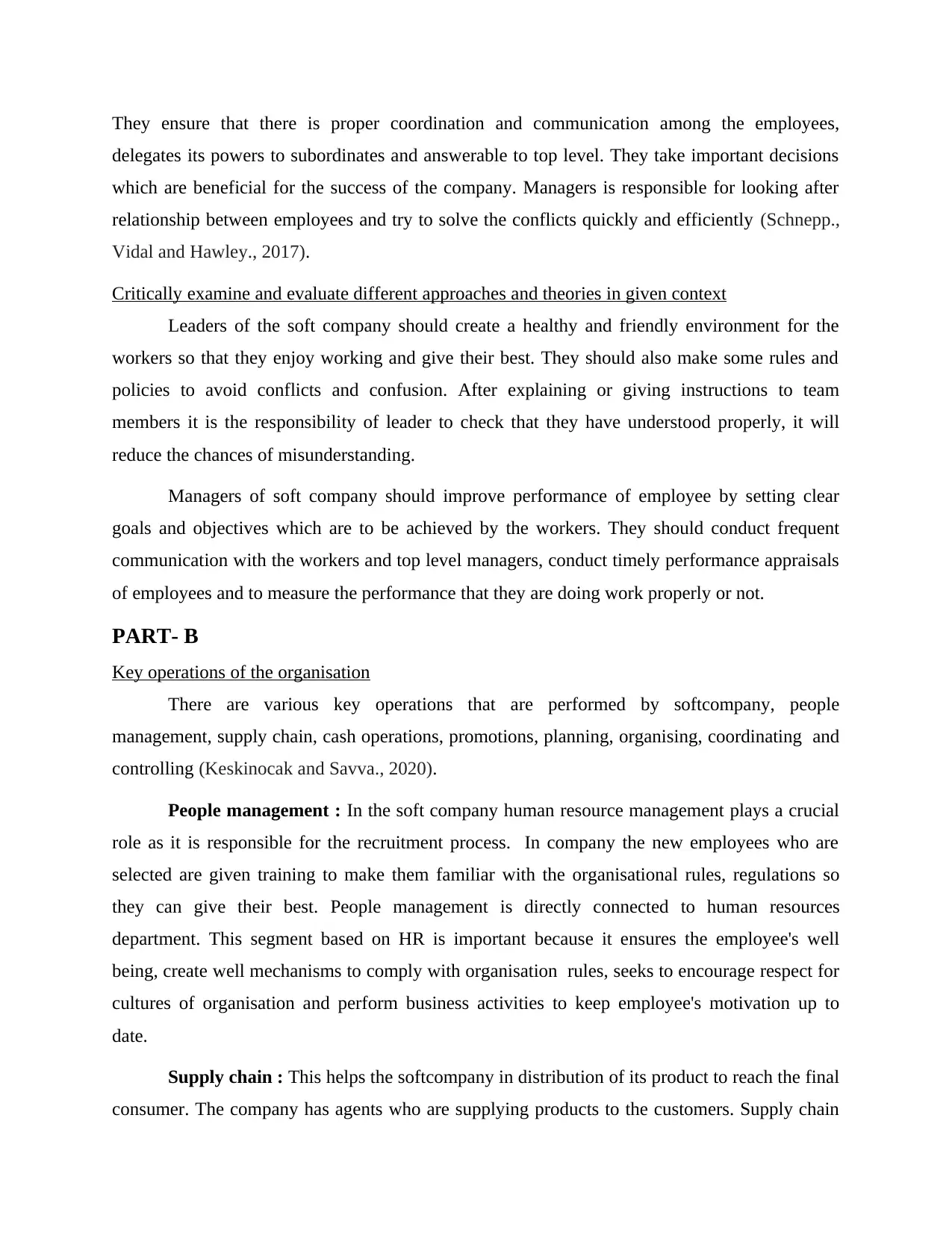
They ensure that there is proper coordination and communication among the employees,
delegates its powers to subordinates and answerable to top level. They take important decisions
which are beneficial for the success of the company. Managers is responsible for looking after
relationship between employees and try to solve the conflicts quickly and efficiently (Schnepp.,
Vidal and Hawley., 2017).
Critically examine and evaluate different approaches and theories in given context
Leaders of the soft company should create a healthy and friendly environment for the
workers so that they enjoy working and give their best. They should also make some rules and
policies to avoid conflicts and confusion. After explaining or giving instructions to team
members it is the responsibility of leader to check that they have understood properly, it will
reduce the chances of misunderstanding.
Managers of soft company should improve performance of employee by setting clear
goals and objectives which are to be achieved by the workers. They should conduct frequent
communication with the workers and top level managers, conduct timely performance appraisals
of employees and to measure the performance that they are doing work properly or not.
PART- B
Key operations of the organisation
There are various key operations that are performed by softcompany, people
management, supply chain, cash operations, promotions, planning, organising, coordinating and
controlling (Keskinocak and Savva., 2020).
People management : In the soft company human resource management plays a crucial
role as it is responsible for the recruitment process. In company the new employees who are
selected are given training to make them familiar with the organisational rules, regulations so
they can give their best. People management is directly connected to human resources
department. This segment based on HR is important because it ensures the employee's well
being, create well mechanisms to comply with organisation rules, seeks to encourage respect for
cultures of organisation and perform business activities to keep employee's motivation up to
date.
Supply chain : This helps the softcompany in distribution of its product to reach the final
consumer. The company has agents who are supplying products to the customers. Supply chain
delegates its powers to subordinates and answerable to top level. They take important decisions
which are beneficial for the success of the company. Managers is responsible for looking after
relationship between employees and try to solve the conflicts quickly and efficiently (Schnepp.,
Vidal and Hawley., 2017).
Critically examine and evaluate different approaches and theories in given context
Leaders of the soft company should create a healthy and friendly environment for the
workers so that they enjoy working and give their best. They should also make some rules and
policies to avoid conflicts and confusion. After explaining or giving instructions to team
members it is the responsibility of leader to check that they have understood properly, it will
reduce the chances of misunderstanding.
Managers of soft company should improve performance of employee by setting clear
goals and objectives which are to be achieved by the workers. They should conduct frequent
communication with the workers and top level managers, conduct timely performance appraisals
of employees and to measure the performance that they are doing work properly or not.
PART- B
Key operations of the organisation
There are various key operations that are performed by softcompany, people
management, supply chain, cash operations, promotions, planning, organising, coordinating and
controlling (Keskinocak and Savva., 2020).
People management : In the soft company human resource management plays a crucial
role as it is responsible for the recruitment process. In company the new employees who are
selected are given training to make them familiar with the organisational rules, regulations so
they can give their best. People management is directly connected to human resources
department. This segment based on HR is important because it ensures the employee's well
being, create well mechanisms to comply with organisation rules, seeks to encourage respect for
cultures of organisation and perform business activities to keep employee's motivation up to
date.
Supply chain : This helps the softcompany in distribution of its product to reach the final
consumer. The company has agents who are supplying products to the customers. Supply chain
Paraphrase This Document
Need a fresh take? Get an instant paraphrase of this document with our AI Paraphraser
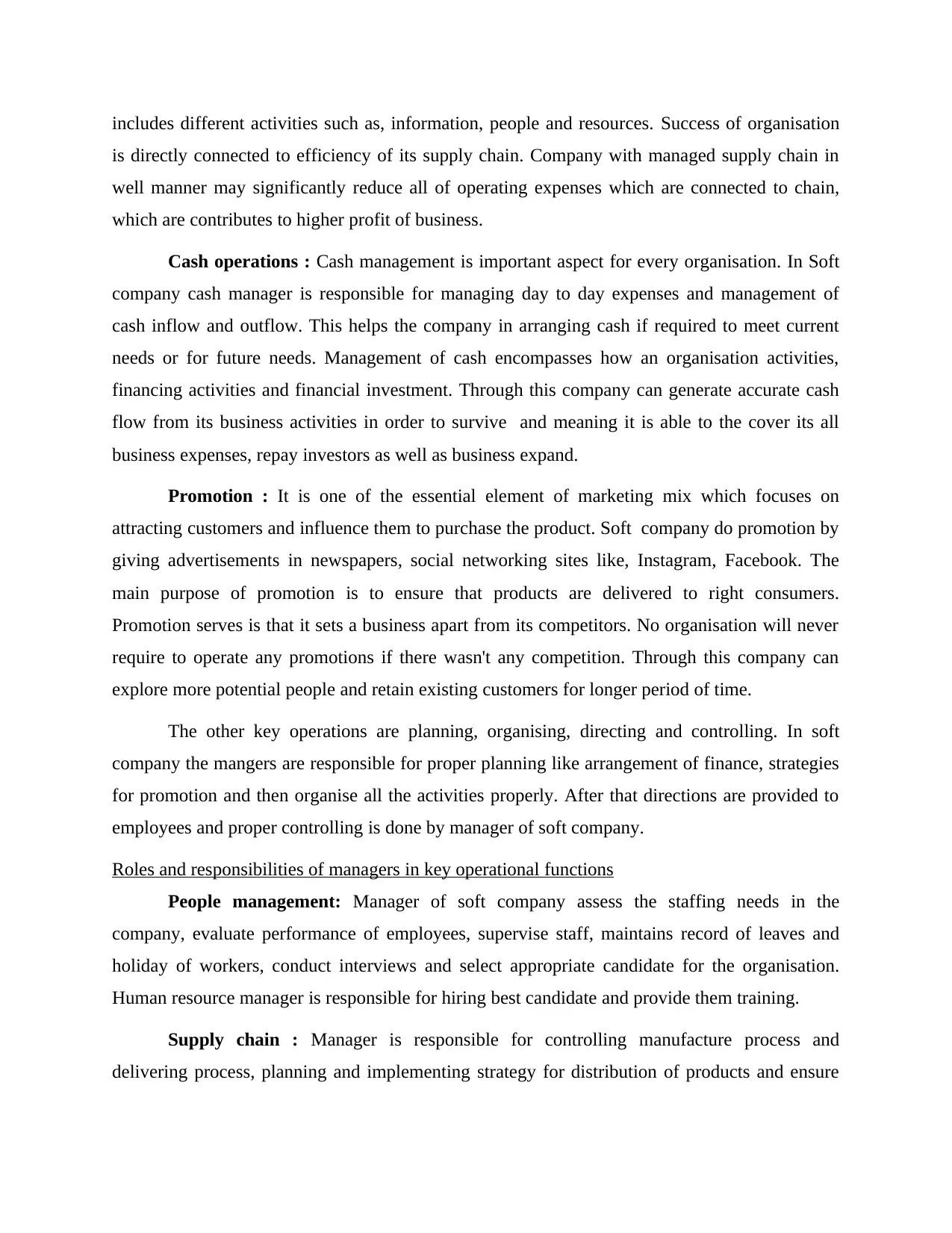
includes different activities such as, information, people and resources. Success of organisation
is directly connected to efficiency of its supply chain. Company with managed supply chain in
well manner may significantly reduce all of operating expenses which are connected to chain,
which are contributes to higher profit of business.
Cash operations : Cash management is important aspect for every organisation. In Soft
company cash manager is responsible for managing day to day expenses and management of
cash inflow and outflow. This helps the company in arranging cash if required to meet current
needs or for future needs. Management of cash encompasses how an organisation activities,
financing activities and financial investment. Through this company can generate accurate cash
flow from its business activities in order to survive and meaning it is able to the cover its all
business expenses, repay investors as well as business expand.
Promotion : It is one of the essential element of marketing mix which focuses on
attracting customers and influence them to purchase the product. Soft company do promotion by
giving advertisements in newspapers, social networking sites like, Instagram, Facebook. The
main purpose of promotion is to ensure that products are delivered to right consumers.
Promotion serves is that it sets a business apart from its competitors. No organisation will never
require to operate any promotions if there wasn't any competition. Through this company can
explore more potential people and retain existing customers for longer period of time.
The other key operations are planning, organising, directing and controlling. In soft
company the mangers are responsible for proper planning like arrangement of finance, strategies
for promotion and then organise all the activities properly. After that directions are provided to
employees and proper controlling is done by manager of soft company.
Roles and responsibilities of managers in key operational functions
People management: Manager of soft company assess the staffing needs in the
company, evaluate performance of employees, supervise staff, maintains record of leaves and
holiday of workers, conduct interviews and select appropriate candidate for the organisation.
Human resource manager is responsible for hiring best candidate and provide them training.
Supply chain : Manager is responsible for controlling manufacture process and
delivering process, planning and implementing strategy for distribution of products and ensure
is directly connected to efficiency of its supply chain. Company with managed supply chain in
well manner may significantly reduce all of operating expenses which are connected to chain,
which are contributes to higher profit of business.
Cash operations : Cash management is important aspect for every organisation. In Soft
company cash manager is responsible for managing day to day expenses and management of
cash inflow and outflow. This helps the company in arranging cash if required to meet current
needs or for future needs. Management of cash encompasses how an organisation activities,
financing activities and financial investment. Through this company can generate accurate cash
flow from its business activities in order to survive and meaning it is able to the cover its all
business expenses, repay investors as well as business expand.
Promotion : It is one of the essential element of marketing mix which focuses on
attracting customers and influence them to purchase the product. Soft company do promotion by
giving advertisements in newspapers, social networking sites like, Instagram, Facebook. The
main purpose of promotion is to ensure that products are delivered to right consumers.
Promotion serves is that it sets a business apart from its competitors. No organisation will never
require to operate any promotions if there wasn't any competition. Through this company can
explore more potential people and retain existing customers for longer period of time.
The other key operations are planning, organising, directing and controlling. In soft
company the mangers are responsible for proper planning like arrangement of finance, strategies
for promotion and then organise all the activities properly. After that directions are provided to
employees and proper controlling is done by manager of soft company.
Roles and responsibilities of managers in key operational functions
People management: Manager of soft company assess the staffing needs in the
company, evaluate performance of employees, supervise staff, maintains record of leaves and
holiday of workers, conduct interviews and select appropriate candidate for the organisation.
Human resource manager is responsible for hiring best candidate and provide them training.
Supply chain : Manager is responsible for controlling manufacture process and
delivering process, planning and implementing strategy for distribution of products and ensure
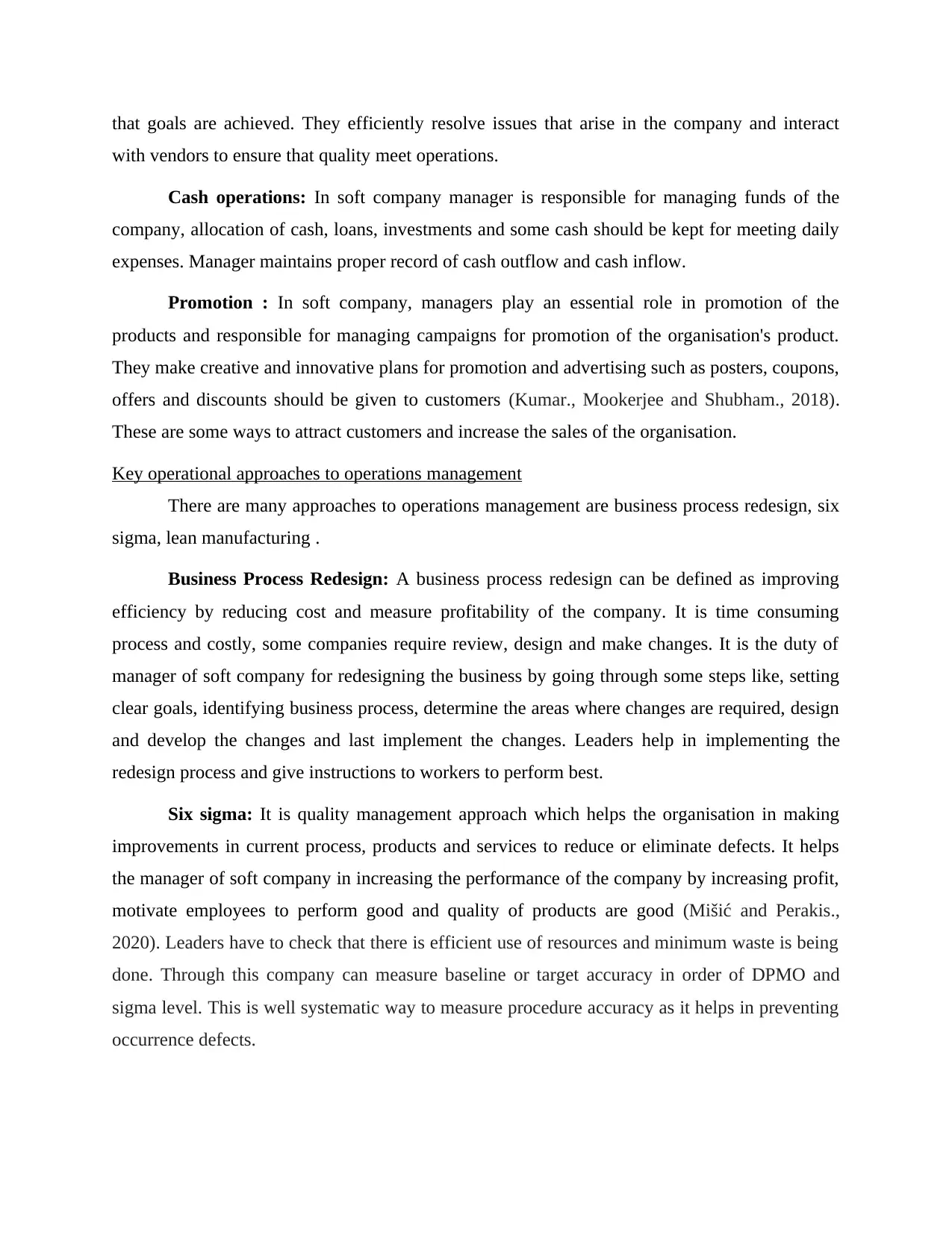
that goals are achieved. They efficiently resolve issues that arise in the company and interact
with vendors to ensure that quality meet operations.
Cash operations: In soft company manager is responsible for managing funds of the
company, allocation of cash, loans, investments and some cash should be kept for meeting daily
expenses. Manager maintains proper record of cash outflow and cash inflow.
Promotion : In soft company, managers play an essential role in promotion of the
products and responsible for managing campaigns for promotion of the organisation's product.
They make creative and innovative plans for promotion and advertising such as posters, coupons,
offers and discounts should be given to customers (Kumar., Mookerjee and Shubham., 2018).
These are some ways to attract customers and increase the sales of the organisation.
Key operational approaches to operations management
There are many approaches to operations management are business process redesign, six
sigma, lean manufacturing .
Business Process Redesign: A business process redesign can be defined as improving
efficiency by reducing cost and measure profitability of the company. It is time consuming
process and costly, some companies require review, design and make changes. It is the duty of
manager of soft company for redesigning the business by going through some steps like, setting
clear goals, identifying business process, determine the areas where changes are required, design
and develop the changes and last implement the changes. Leaders help in implementing the
redesign process and give instructions to workers to perform best.
Six sigma: It is quality management approach which helps the organisation in making
improvements in current process, products and services to reduce or eliminate defects. It helps
the manager of soft company in increasing the performance of the company by increasing profit,
motivate employees to perform good and quality of products are good (Mišić and Perakis.,
2020). Leaders have to check that there is efficient use of resources and minimum waste is being
done. Through this company can measure baseline or target accuracy in order of DPMO and
sigma level. This is well systematic way to measure procedure accuracy as it helps in preventing
occurrence defects.
with vendors to ensure that quality meet operations.
Cash operations: In soft company manager is responsible for managing funds of the
company, allocation of cash, loans, investments and some cash should be kept for meeting daily
expenses. Manager maintains proper record of cash outflow and cash inflow.
Promotion : In soft company, managers play an essential role in promotion of the
products and responsible for managing campaigns for promotion of the organisation's product.
They make creative and innovative plans for promotion and advertising such as posters, coupons,
offers and discounts should be given to customers (Kumar., Mookerjee and Shubham., 2018).
These are some ways to attract customers and increase the sales of the organisation.
Key operational approaches to operations management
There are many approaches to operations management are business process redesign, six
sigma, lean manufacturing .
Business Process Redesign: A business process redesign can be defined as improving
efficiency by reducing cost and measure profitability of the company. It is time consuming
process and costly, some companies require review, design and make changes. It is the duty of
manager of soft company for redesigning the business by going through some steps like, setting
clear goals, identifying business process, determine the areas where changes are required, design
and develop the changes and last implement the changes. Leaders help in implementing the
redesign process and give instructions to workers to perform best.
Six sigma: It is quality management approach which helps the organisation in making
improvements in current process, products and services to reduce or eliminate defects. It helps
the manager of soft company in increasing the performance of the company by increasing profit,
motivate employees to perform good and quality of products are good (Mišić and Perakis.,
2020). Leaders have to check that there is efficient use of resources and minimum waste is being
done. Through this company can measure baseline or target accuracy in order of DPMO and
sigma level. This is well systematic way to measure procedure accuracy as it helps in preventing
occurrence defects.
⊘ This is a preview!⊘
Do you want full access?
Subscribe today to unlock all pages.

Trusted by 1+ million students worldwide
1 out of 18
Related Documents
Your All-in-One AI-Powered Toolkit for Academic Success.
+13062052269
info@desklib.com
Available 24*7 on WhatsApp / Email
![[object Object]](/_next/static/media/star-bottom.7253800d.svg)
Unlock your academic potential
Copyright © 2020–2025 A2Z Services. All Rights Reserved. Developed and managed by ZUCOL.




